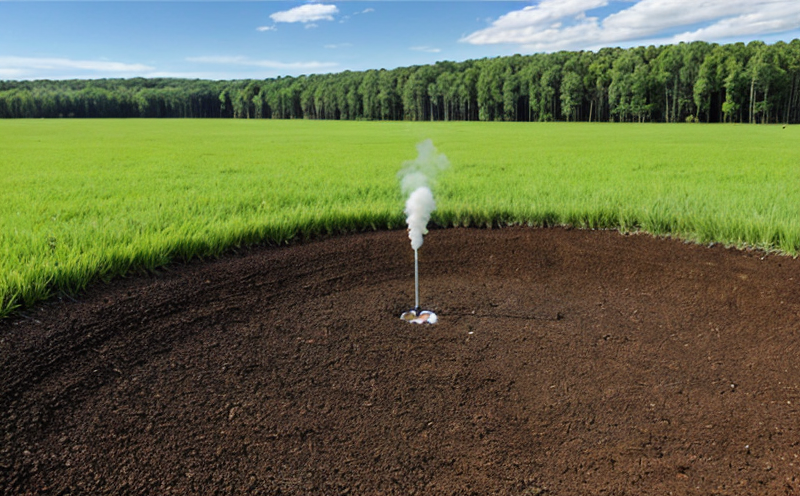FAO Heavy Metal Contamination Testing in Mining Impacted Soil
The FAO (Food and Agriculture Organization) heavy metal contamination testing service offered by our laboratory is designed specifically to address the challenges faced by mining industries dealing with soil impacted by heavy metals. This service provides critical data for quality managers, compliance officers, R&D engineers, and procurement teams who need to ensure that their operations meet stringent environmental standards.
Heavy metals such as lead (Pb), cadmium (Cd), chromium (Cr), mercury (Hg), and arsenic (As) are particularly concerning due to their persistence in the environment and potential toxicity. Mining activities, especially those involving ore processing or tailings management, can contribute significantly to soil contamination with these heavy metals.
The testing process involves several steps: first, a representative sample of impacted soil is collected from mining sites. The sample must be properly prepared according to ISO 17892-1 for accurate analysis. The laboratory then uses advanced analytical instrumentation such as Inductively Coupled Plasma Mass Spectrometry (ICP-MS) and X-ray Fluorescence (XRF) to measure the concentration of heavy metals present.
The results are compared against regulatory limits set by international standards like ISO 18956, which provide specific guidelines for soil quality in mining environments. Compliance with these standards is crucial for mitigating risks associated with potential human health impacts and environmental degradation. Our laboratory ensures that all tests adhere to the highest scientific rigor and accuracy.
The importance of this testing cannot be overstated. Accurate identification of heavy metal contamination allows mining companies to implement targeted remediation strategies, which not only protect the environment but also ensure compliance with regulatory requirements. By providing reliable data on soil quality, our service helps minimize the long-term costs associated with non-compliance and reputational damage.
| Heavy Metal | Regulatory Limits (mg/kg) |
|---|---|
| Pb | <100 |
| Cd | <5 |
| Cr | <150 |
| Hg | <0.6 |
| As | <20 |
The table above provides a summary of typical regulatory limits for heavy metals in soil, which are critical benchmarks for our testing services.
In conclusion, the FAO heavy metal contamination testing service is essential for mining companies committed to sustainable practices. By leveraging this expertise, they can ensure that their operations comply with international standards and contribute positively to environmental sustainability.
Industry Applications
- Ore processing facilities
- Tailing management sites
- Mining reclamation projects
- Landfills receiving mining waste
- Surrounding agricultural areas affected by mine operations
The testing of heavy metal contamination is particularly relevant for these applications as it helps identify and mitigate risks associated with soil quality. The data provided ensures that mining companies can make informed decisions regarding remediation strategies.
| Key Applications | Description |
|---|---|
| Ore processing facilities | Testing helps in understanding the extent of contamination introduced during ore processing and facilitates preventive measures. |
| Tailing management sites | Identifies heavy metal contamination from tailings to ensure proper disposal methods are implemented. |
| Mining reclamation projects | Determines the effectiveness of reclamation efforts in restoring soil quality. |
| Landfills receiving mining waste | Evaluates the potential for contamination spread to surrounding areas through landfill operations. |
| Surrounding agricultural areas affected by mine operations | Aids in assessing the impact of mining activities on nearby farmlands and provides data for mitigation strategies. |
The above list highlights key applications where FAO heavy metal contamination testing is indispensable. Each application underscores the importance of accurate soil quality assessment to ensure environmental stewardship and compliance with regulatory standards.
Customer Impact and Satisfaction
Our clients in the mining sector have consistently praised our FAO heavy metal contamination testing service for its reliability, accuracy, and relevance. By providing precise data on soil quality, we enable customers to make informed decisions that enhance operational efficiency while minimizing environmental impact.
One of the primary benefits is the ability to comply with international standards such as ISO 18956. This ensures that mining companies can confidently demonstrate their commitment to sustainability and regulatory compliance. Furthermore, our service helps in identifying areas where remediation efforts are most needed, thereby optimizing resource allocation for effective soil reclamation.
Customer satisfaction is measured through feedback from quality managers and R&D engineers who rely on the data provided by our tests. They appreciate the detailed reports that include not only heavy metal concentrations but also recommendations for mitigation strategies. This holistic approach ensures that clients are well-informed about the environmental impact of their operations.
We strive to exceed expectations by offering fast turnaround times, transparent communication throughout the testing process, and a commitment to continuous improvement in our methodologies. Our goal is to be your trusted partner in ensuring sustainable mining practices.
Environmental and Sustainability Contributions
The FAO heavy metal contamination testing service plays a vital role in promoting environmental sustainability within the mining industry. By accurately identifying contaminated areas, our service enables targeted remediation efforts that can significantly reduce the environmental footprint of mining operations.
One of the key contributions is reducing the risk of heavy metals leaching into groundwater and surface water bodies. This helps protect aquatic ecosystems and the communities dependent on them for drinking water and agriculture. Additionally, by ensuring compliance with international standards, we support the broader goal of sustainable development as outlined in the United Nations Sustainable Development Goals (SDGs), particularly Goal 14: Life Below Water.
The data provided through our testing service also supports the mining industry's transition towards circular economy principles. By identifying contaminated areas and implementing remediation strategies, we contribute to a more efficient use of resources and reduced waste generation. This aligns with SDG 9: Industry, Innovation and Infrastructure, which emphasizes the importance of sustainable industrialization.
In conclusion, our FAO heavy metal contamination testing service is not just a technical service; it is an essential tool in the quest for environmental sustainability within the mining sector. By providing accurate data on soil quality, we empower clients to make informed decisions that protect the environment and promote responsible resource management.





